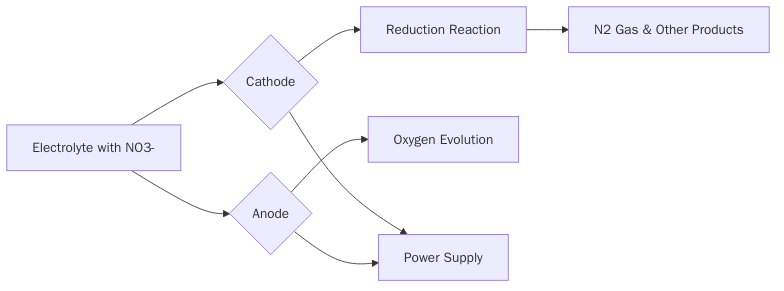Efficient Electrochemical Nitrate Reduction to Optimize the Nitrogen Cycle
Abstract
This study investigates the potential of electrochemical nitrate reduction (ECNR) technology in optimizing the nitrogen cycle, addressing the critical issue of nitrate pollution. By examining various electrode materials, operational parameters, and system designs, the research aims to enhance the efficiency and selectivity of nitrate reduction. Experimental results reveal significant variations in nitrate reduction efficiency among different electrode materials, with platinum demonstrating the highest performance. The study underscores the importance of material selection, electrolyte conditions, and precise control of operational parameters in achieving effective nitrate remediation. The findings contribute valuable insights for both academic research and practical applications, highlighting ECNR’s promise in mitigating nitrate pollution and promoting a healthier nitrogen cycle.
References
Guo, R., et al. (2024). Bimetal anchoring porous MXene nanosheets for driving tandem catalytic high‐efficiency electrochemical nitrate reduction. AIChE Journal. https://doi.org/10.1002/aic.18628
Kindra, V., et al. (2023). Research on oxy-fuel combustion power cycle using nitrogen for turbine cooling. Archives of Thermodynamics, 44(1), 3–24. https://doi.org/10.24425/ather.2020.135859
Ni, J., et al. (2024). Atomic Co─P catalytic pair drives efficient electrochemical nitrate reduction to ammonia. Advanced Energy Materials. https://doi.org/10.1002/aenm.202400065
Park, J., et al. (2018). Optimization and sensitivity analysis of the nitrogen Brayton cycle as a power conversion system for a sodium-cooled fast reactor. Nuclear Engineering and Design, 338, 206–214. https://doi.org/10.1016/j.nucengdes.2018.09.037
Rad, E. A., et al. (2023). Thermodynamic feasibility and multiobjective optimization of a closed Brayton cycle-based clean cogeneration system. Journal of Thermal Analysis and Calorimetry, 149, 1199–1218. https://doi.org/10.1007/s10973-023-12630-2
Shen, Z., et al. (2021). Pd–In bimetallic nanoparticles supported on chelating resin for nitrate removal from water: High efficiency and low NH₄⁺ selectivity. Environmental Science: Water Research & Technology, 7, 1892–1902. https://doi.org/10.1039/D1EW00028D
Shi, J., et al. (2022). Preparing porous Cu/Pd electrode on nickel foam using hydrogen bubbles dynamic template for high-efficiency and high-stability removal of nitrate from water. Environmental Science and Pollution Research, 29, 57629–57643. https://doi.org/10.1007/s11356-022-19942-0
Song, J.-B., et al. (2023). Removal of nitrate by FeSiBC metallic glasses: High efficiency and superior reusability. Physical Chemistry Chemical Physics, 25, 30612–30621. https://doi.org/10.1039/d3cp04280d
Wang, Y., et al. (2023). High-efficiency mixotrophic denitrification for nitrate removal in high-sulfate wastewater using UASB reactor. Water, 15(15), 2819. https://doi.org/10.3390/w15152819
Xiong, Y., et al. (2024). Metal doped unconventional phase IrNi nanobranches: Tunable electrochemical nitrate reduction performance and pollutants upcycling. Environmental Science & Technology. https://doi.org/10.1021/acs.est.4c04014
Yang, L., et al. (2024). Frustrated Lewis pairs on Zr single atoms supported N‐doped TiO₂‐x catalysts for electrochemical nitrate reduction to ammonia. Advanced Functional Materials. https://doi.org/10.1002/adfm.202401094
Zhang, K., et al. (2024). Electrochemical nitrate reduction to ammonia on CuCo nanowires at practical level. Advanced Functional Materials. https://doi.org/10.1002/adfm.202405179
Zhang, Z., et al. (2022). Impacts of fertilization optimization on soil nitrogen cycling and wheat nitrogen utilization under water-saving irrigation. Frontiers in Plant Science, 13, Article 878424. https://doi.org/10.3389/fpls.2022.878424
Zhou, J., et al. (2024). Efficient and selective electrochemical nitrate reduction to N₂ using a flow-through zero-gap electrochemical reactor with a reconstructed Cu(OH)₂ cathode: Insights into the importance of inter-electrode distance. Environmental Science & Technology. https://doi.org/10.1021/acs.est.3c10936


This work is licensed under a Creative Commons Attribution 4.0 International License.
Copyright for this article is retained by the author(s), with first publication rights granted to the journal.
This is an open-access article distributed under the terms and conditions of the Creative Commons Attribution license (http://creativecommons.org/licenses/by/4.0/).
























